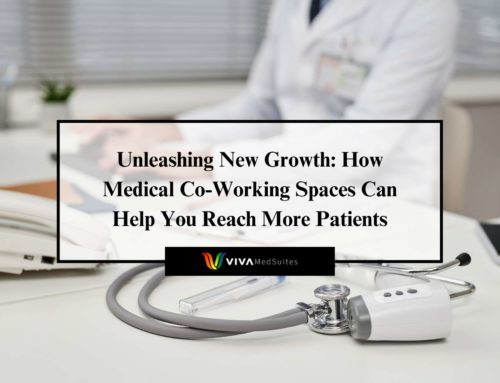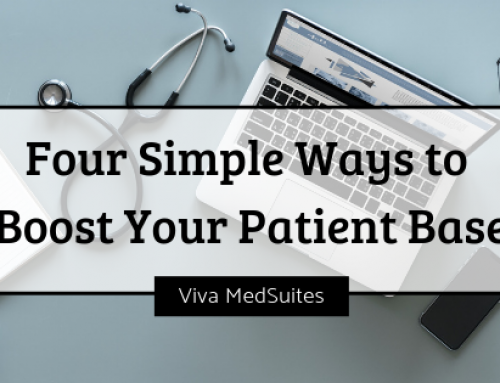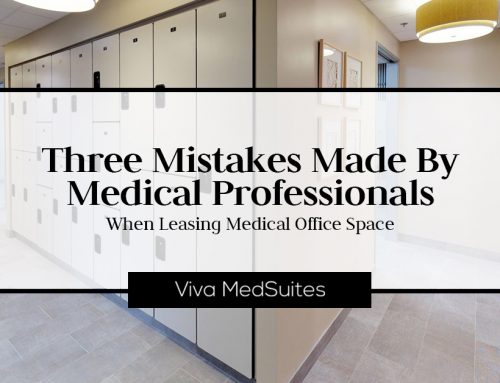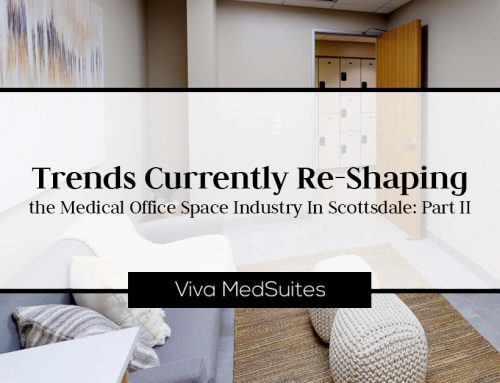When it comes to leasing medical office space, there have been three basic options for the independent physician or medical practitioner — 1) Direct Leasing 2) Subleasing and 3)Traditional Timesharing.
In this article we’ll summarize the main pros and cons of each option and also introduce a new option, which has not really been available for medical office users until very recently- that is the option of medical co-working + timesharing. Viva MedSuites is the first to innovate and create this new option which, for the right type of space needs is a much better solution on many levels. But for certain space needs, the older more traditional options might still be a better fit. Below, we have created an infographic that illustrates the various pros and cons associated with each type of office leasing options.

*If you would like more information regarding each type of medical office leasing system, continue reading below.
Direct Leasing
This is the most common way that most physicians and medical practitioners operate and has been around since doctors first started having patients come to them instead of them going to patients. In a direct lease, the responsible party signs a multi-year lease on a medical office space and they have the space all to themselves and are responsible for 100% of the rent, overhead, taxes, utilities, CAMs, etc. They also bear 100% of the risk and have to come up with 100% of the upfront costs to furnish, equip and decorate the space, as well as often having to pay for the physical build-out of the interior improvements or the upgrading of the existing improvements as well as the maintenance and repairs during their lease.
Another thing to consider is that most medical office buildings will only break their spaces down so small or won’t be willing to demise their space differently than it already is. Most medical office buildings won’t (and can’t really) break their spaces down to much below 1,500 to 2,000 SF. So if you need less than that amount of space, you’ll have to take on more space than you really need and be strapped with more overhead expenses than you actually need. Often this space will just go unutilized or for those that want to deal with the hassle of subleasing, you can sometimes find other medical practitioners to come in and sublease some of your excess space.
The multi year lease also presents its own risk. Direct leasing of medical office space typically requires a 3-5+ year lease agreement, so if your space needs change up or down within that lease term, you’re stuck with the space you have until the lease term is up. In other words, direct leasing is very inflexible to changing needs.
Here’s a summary of the pros and cons of direct leased medical office space:
Pros
- Full control of space (within parameters provided by building owner)
Cons
- Full burden of upfront costs to design, build out, furnish, equip and decorate
- Full burden of lease risk, typically required to sign personal guarantee- guaranteeing the full rent for the full term of the lease
- Full burden of rent, CAMs, taxes, utilities
- Full burden of ongoing supplies, janitorial services, repairs and maintenance
- If your space needs are less than 1,500 to 2,000 SF you will likely have to take on more space than you need
- Inflexible- typically you’ll be locked into your space for 3-5+ years
Often when medical office users look at their costs of leasing direct space, they underestimate the true occupancy costs by only looking at the monthly rent.
In addition to your stated rent, you should also consider all the other occupancy costs you’ll pay on a monthly basis:
1) rental sales tax of about 2% of your stated rent
2) Building common area maintenance assessments (CAMs)
3) Property Insurance
4) Real Estate taxes,
5) Utilities and
6) Janitorial
To account for all of these additional costs that you’ll pay over and above your rent you should plan on an additional $1.00/SF monthly- so for a space of $1,500 SF- you’ll need to budget another $1,500/mo on top of your rent to cover these costs.
BEST FOR: Established practices that use it for their primary office and can fully utilize at least 1,500 to 2,000+ SF on a full time (4-5 days per week) basis.
TOTAL OCCUPANCY COST RANGE: $4,000 – $5,000+/mo
Subleasing
Now let’s consider the subleasing option. The first thing to know is that subleasing is a very hit and miss thing. There is no simple online directory you can look at to find and compare subleasing options in the area you want to be. You’ll have to do a lot of poking around to stumble upon someone that is wanting to sublease some of their excess space. Even if you do find a sublease option in a location you want to be, you’ll have very little control over the space as you’re really just subleasing a portion of their space. You’ll have to live by their rules, their design, their hours. And it’s only fair- as they are the ones that have all the risk and expense and inflexibility of the direct leased space. So you’ll be working out of their shadow and if their practice grows and they need to re-capture their space, you’ll be the first to go. You’ll also have to get pretty comfortable with sharing things like the reception area, bathrooms, break room, lab space, etc. always knowing that you are not equals. They are in charge and you are not.
Typically in a subleasing arrangement you will pay the primary tenant a monthly rent per your agreement and also cover a percentage of the overhead costs of the space. Make sure you are clear on what those are. From a pure cost perspective, subleasing obviously saves you lots of money- both up front and monthly. You typically also have a shorter term agreement that is either month-to-month or maybe 6 or 12 months.
Pros
- No upfront costs to design, build-out, furnish and equip the space
- Shorter term agreements provide higher flexibility if your needs change
- Lower monthly overhead than direct leased space
- Typically not time-shared- so you have full time access/use of the portion of the space you are subleasing.
Cons
- Hard to find the right fit
- You are in low control position and have to live by the primary tenant’s rules
- You can easily be kicked out if they don’t like you or if their needs change and they need to recapture the space for their own use
BEST FOR: New practices just getting started or with limited patient base and small space needs of 1-2 rooms. Also may work as satellite office for an established practice that wants to see patients in a different part of town but can’t justify opening a 2nd direct leased space.
TOTAL OCCUPANCY COST RANGE: $800 – $1500+/mo per room
Timesharing
Sometimes there are medical office buildings that will build out a smaller spec suite of 1,500 to 2,000 SF and timeshare it. This is most common in medical office buildings that are on hospital campuses where the hospital group has full control/rights of approval over everyone that uses the space. Typically this means that they will only allow uses that don’t compete with their own practice groups and they will require you to pay for hospital rights whether you use them or not.
The way these standard medical timeshares work is that one practice has exclusive use of the entire timeshare space on the day or days that they pay for. So there is only ever one practitioner using the space on any given day. Building owners with timeshare units don’t want to deal with the management hassle of having more than one practitioner in the space at the same time. So while this can be a helpful solution for a practice that only wants part-time access, they still will be taking on the entire 1,500 – 2,000 SF whether they need that much space or not.
Pros
- Good for practices that only need to see patients one or two days per week and can utilize the full space effectively
- Higher degree of flexibility than direct lease
- Typically come pre-built-out and furnished
Cons
- Typically only found in hospital controlled medical office buildings and require hospital management approval of your use and the monthly fees of hospital “privileges” over and above the rent (whether you use the hospital resources or not)
- Have to pay for the daily rate of the full space even if you don’t need that much space. Typical daily rates for typically sized timeshare suites are $400 – $500 per day
- Medical office buildings that do timeshare suites will typically take the space that is hardest to lease directly (least desirable) and turn it into a timeshare suite. So you’ll be using the least desirable space in the building- often at the end of a long hall or tucked away in the back with no window views
- Often dated/old build-out
BEST FOR: Established practices that can fully utilize 1,500 – 2,000 SF on a regular weekly basis, but only one or two days per week. Good for specialists/hospitalists that are in the hospital 3-4 days a week but also need to see patients for pre-post operative checkups 1-2 days per week.
TOTAL OCCUPANCY COST RANGE: $1,500 to $3,000/mo for one full day per week
Medical Co-working Timeshare Space
Viva MedSuites is the creator of a new kind of medical office space that does a better job at being the right overall fit for some types of physicians and medical practitioners. Viva MedSuites brings to the medical office user many of the same resource sharing, cost sharing and networking benefits that co-working operators like We Work and Regus (and many others) have brought to the standard office user for many years now.
But in addition to being a co-working space for medical uses, Viva MedSuites also brings the benefit of being a timeshare that most standard office co-working operators don’t offer. However, Viva MedSuites also expands on the typical timeshare concept by breaking it down much more granularly. Physicians and medical office users can access Viva MedSuites space down to a single exam room for a single hour or up to one or more exam rooms for several days per week or even full time.
Like co-working operators, We Work and Regus, Viva MedSuites offers “Service Agreements” in their space rather than leasing or sub-leasing.
Viva MedSuites offers three levels of membership:
Pay As You Go Plan(PAYG)– Where members pay a small weekly membership fee and then can schedule and book exam rooms as needed for a fixed hourly rate. This is ideal for uses that only need exam room space on a sporadic or irregular basis. Members have access to a private member portal to view the availability of each room and book it in increments as small as one hour.
Weekly Plan– Members commit to and are guaranteed use of a specific room on a specific day or days every week. Each day is broken into 3 time blocks. Morning (7:00 am to 12:00 pm), Afternoon (12:30 pm to 5:30 pm) and Evening (6:00 pm to 10:00 pm). There is a two block/week minimum for the Weekly plan.
Exclusive Use Plan– Members can sign up for exclusive use of a single exam room that is not time-shared. They then have 24/7 access to the room.
Pricing is all inclusive. You won’t pay anything else for CAMS, rental taxes, real estate taxes, insurance, utilities, janitorial, repair & maintenance, etc.. To see specific pricing for each of the plans, go to the pricing page at www.vivamedsuites.com/pricing.
Terms are very flexible and scalable. PAYG plans can be terminated at any time with a 4 week written notice and Weekly and Exclusive Plans can be terminated at any time with a 12 week written notice.
Pros:
- High Impact/High image locations you’ll be proud to bring patients to. Access to higher quality locations and space than you could typically have access to on your own for smaller space or part-time space requirements.
- Use of large office resources such as large patient waiting room, automated kiosk patient check in/notification system, bathrooms, break room, lab space, MA stations etc.
- Equal user to all others. Co-working equality, not sub-tenant or shadow tenant.
- No capital outlay up front to furnish, equip or decorate the space.
- Immediate Occupancy- no waiting for lease negotiation, approval, renovations, decorating, furnishing, etc. Move in tomorrow.
- No personal guarantee.
- Rooms are fully furnished, equipped and decorated.
- Pay weekly membership fees by checking, debit or even credit card.
- Highly scalable- start with exactly what you need and grow it incrementally as your needs require.
- Highly flexible- you’re never locked into a long term agreement. Short term notice to terminate at any time.
- Lockers and mini-fridges available/optional for storing your supplies in onsite so you don’t have to bring and take everything with you on the days you use the space.
- Networking with other independent medical practitioners utilizing the same facility. Good way to develop professional friendships, patient referrals, etc.
- Access to valuable practice building and management services that are exclusively available to Viva MedSuites members. For example- sophisticated and comprehensive online marketing services to dominate online for your category and geography.
Cons:
- If your practice needs are full time (4-5 days per week) and you need to have 2 or more exam rooms and MA stations, the monthly cost may approach or exceed what you can find by subleasing space in someone else’s practice or doing your own direct leasing (which comes with their own downside as already spelled out above).
- Unless you are doing an exclusive room plan, you will need to leave the room in good clean condition for the next person using that room after you. That means removing any personal items, tools, etc. and placing them in your locker and emptying your trash if needed into the larger trash bin in the common break room.
BEST FOR: Any type of medical, wellness or counseling practice that wants to be in a medical office space environment but whose space needs are small or part-time in nature. Great for new and growing practices, or for more established practices whose needs are for part-time or satellite offices. Also great for scaling back and simplifying from larger overhead direct leased spaces.
TOTAL OCCUPANCY COST RANGE: $200/mo (PAYG). $600 – $1500/mo for typical Weekly Plan uses. $2,000/mo for exclusive room.
The medical office space market has not innovated in a long time. The options of direct leasing, subleasing and timesharing have been around for at least a century. Meanwhile the needs and demands of many medical office users have changed significantly in recent years. For certain traditional larger doctors office users, the standard options out there may still be the best fit for their needs, but for a growing segment of medical office users who need greater flexibility, scalability and lower risk and overhead, Viva MedSuites brings a new medical office option to the market that may be just what you’ve been looking for but couldn’t find until now.
Published By
Viva MedSuites
9700 N. 91st St., Suite A-115
Scottsdale, Arizona 85258
Phone: 480-586-0234
Email: john@vivamedsuites.com
Website: vivamedsuites.com







